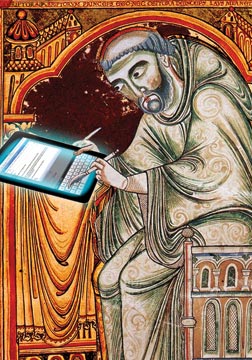Monday, April 22, 2013
5:00 p.m.
Room 201 O’Shaughnessy Hall
SPEAKERS:
Andre Murnieks
(Department of Art, Art History, & Design, University of Notre Dame)
The Future Is Medialess™
Print is not dead; but it is dying very, very slowly. In its current incarnation, the book is a difficult medium to improve upon. It is entrenched in culture and serves us well. It is bound (ouch!) to long standing systems, processes and technologies. Publishers and libraries are part of the system structure. Printing and binding are processes. And the technologies include the press, paper and ink. Yet, there is a viable alternative that supplants every single one of these systems, processes and technologies. The iPad is that threat. The controversy is whether a screen-based device can replace a book. It can—but that is not important. The problem is that we have to choose a medium in the first place. What if the content was divorced from the medium? What if the message was the media of one’s choosing? There are two parts of this puzzle to solve: 1. the content must be aware of its own structure, 2. the content must reside in a place accessible to all people and media devices. Web technologies are already answering the first call with tagged content that is responsive to the type of media it is being displayed upon. The same website may be displayed in a browser, tablet, mobile phone or smart TV—and it looks good. To the second point, the living space of all things digital is the Cloud. The concept of the cloud is a nebulous space filled with all kinds of data and that has no location. Yet it is everywhere you go. Now imagine the possibilities: perhaps one publisher can deliver a digital version of a literary masterpiece instantly to a futuristic device to go along with ten other textbooks a young college student must tote; but perhaps another publisher can take that same content and create a print-on-demand replica complete with leather binding and gold-leaf type. In the space between there could thrive a DIY subculture ever exploring the notion of the book.
As part of Prof. Murnieks’s talk, we will also get a chance to see three design project demonstrations:
A Purrrfect Match, an interactive story about finding true love in today’s society –
Anna Young, BFA Design Candidate
Amber, an interactive, handheld device for collecting life’s experiences –
Alisa Rantanen, BFA Design Candidate
Spectre: A Ghostly Tale of Whisps & Whimsy, a dark, hypermedia fairytale for children –
Sarah Martin, Design Graduate Student
Megan Hall
(Department of English, University of Notre Dame)
Everything Old Is New Again
Web Publishing as Reinvention of Medieval Manuscript Culture
Many at the forefront of the digital humanities pride themselves on their swift rush away from a hard-copy, past a creaking, fixed inflexibility that must be escaped. Medievalists have long known this thinking to be flawed, though, or at least shortsighted, for much of what are considered new ways of reading and producing books are in fact simply repackagings of tried-and-true methods of manuscript culture. Consider the wax tablet and the iPad, the reading coterie of Langland and bloggers, or the equal difficulty of accessing out-of-print hard-copy editions and CD-ROM editions built on obsolescent platforms: while the New (Digital) Media may offer a flexibility and interconnectedness of resources that the Old (Print) Media cannot, the New can never truly outpace the Old, and we would do well to remember it.
